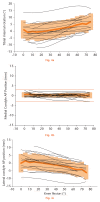Can a total knee arthroplasty be both rotationally unconstrained and anteroposteriorly stabilised? A pulsed fluoroscopic investigation
- PMID: 26965166
- PMCID: PMC4852793
- DOI: 10.1302/2046-3758.53.2000621
Can a total knee arthroplasty be both rotationally unconstrained and anteroposteriorly stabilised? A pulsed fluoroscopic investigation
Abstract
Objectives: Throughout the 20th Century, it has been postulated that the knee moves on the basis of a four-bar link mechanism composed of the cruciate ligaments, the femur and the tibia. As a consequence, the femur has been thought to roll back with flexion, and total knee arthroplasty (TKA) prostheses have been designed on this basis. Recent work, however, has proposed that at a position of between 0° and 120° the medial femoral condyle does not move anteroposteriorly whereas the lateral femoral condyle tends, but is not obliged, to roll back - a combination of movements which equates to tibial internal/ femoral external rotation with flexion. The aim of this paper was to assess if the articular geometry of the GMK Sphere TKA could recreate the natural knee movements in situ/in vivo.
Methods: The pattern of knee movement was studied in 15 patients (six male: nine female; one male with bilateral TKAs) with 16 GMK Sphere implants, at a mean age of 66 years (53 to 76) with a mean BMI of 30 kg/m(2) (20 to 35). The motions of all 16 knees were observed using pulsed fluoroscopy during a number of weight-bearing and non-weight-bearing static and dynamic activities.
Results: During maximally flexed kneeling and lunging activities, the mean tibial internal rotation was 8° (standard deviation (sd) 6). At a mean 112° flexion (sd 16) during lunging, the medial and lateral condyles were a mean of 2 mm (sd 3) and 8 mm (sd 4) posterior to a transverse line passing through the centre of the medial tibial concavity. With a mean flexion of 117° (sd 14) during kneeling, the medial and lateral condyles were a mean of 1 mm (sd 4) anterior and 6 mm (sd 4) posterior to the same line. During dynamic stair and pivoting activities, there was a mean anteroposterior translation of 0 mm to 2 mm of the medial femoral condyle. Backward lateral condylar translation occurred and was linearly related to tibial rotation.
Conclusion: The GMK Sphere TKA in our study group shows movements similar in pattern, although reduced in magnitude, to those in recent reports relating to normal knees during several activities. Specifically, little or no translation of the medial femoral condyle was observed during flexion, but there was posterior roll-back of the lateral femoral condyle, equating to tibiofemoral rotation. We conclude that the GMK Sphere is anteroposteriorly stable medially and permits rotation about the medial compartment.Cite this article: Professor G. Scott. Can a total knee arthroplasty be both rotationally unconstrained and anteroposteriorly stabilised?: A pulsed fluoroscopic investigation. Bone Joint Res 2016;5:80-86. DOI: 10.1302/2046-3758.53.2000621.
Keywords: TKA; knee fluoroscopy; knee kinematics; total knee arthroplasty.
© 2016 Scott et al.
Conflict of interest statement
Figures






Similar articles
-
In Vivo Knee Kinematics for a Cruciate Sacrificing Total Knee Arthroplasty Having Both a Symmetrical Femoral and Tibial Component.J Arthroplasty. 2020 Jun;35(6):1712-1719. doi: 10.1016/j.arth.2020.02.004. Epub 2020 Feb 8. J Arthroplasty. 2020. PMID: 32111514
-
Stair Climbing and High Knee Flexion Activities in Bi-Cruciate Retaining Total Knee Arthroplasty: In Vivo Kinematics and Articular Contact Analysis.J Arthroplasty. 2019 Mar;34(3):570-576. doi: 10.1016/j.arth.2018.11.013. Epub 2018 Nov 16. J Arthroplasty. 2019. PMID: 30514641
-
Does lateral lift-off occur in static and dynamic activity in a medially spherical total knee arthroplasty? A pulsed-fluoroscopic investigation.Bone Joint Res. 2019 Jun 5;8(5):207-215. doi: 10.1302/2046-3758.85.BJR-2018-0237.R1. eCollection 2019 May. Bone Joint Res. 2019. PMID: 31214333 Free PMC article.
-
The movement of the knee studied by magnetic resonance imaging.Clin Orthop Relat Res. 2003 May;(410):35-43. doi: 10.1097/01.blo.0000063598.67412.0d. Clin Orthop Relat Res. 2003. PMID: 12771815 Review.
-
In vivo kinematics of medial unicompartmental osteoarthritic knees during activities of daily living.Knee. 2014;21 Suppl 1:S10-4. doi: 10.1016/S0968-0160(14)50003-8. Knee. 2014. PMID: 25382361 Review.
Cited by
-
Retention of the posterior cruciate ligament stabilizes the medial femoral condyle during kneeling using a tibial insert with ball-in-socket medial conformity.Int Orthop. 2024 Sep;48(9):2395-2401. doi: 10.1007/s00264-024-06251-z. Epub 2024 Jul 13. Int Orthop. 2024. PMID: 38997513
-
Kinematic Performance of Medial Pivot Total Knee Arthroplasty.J Arthroplasty. 2024 Jun;39(6):1595-1601.e7. doi: 10.1016/j.arth.2023.11.038. Epub 2023 Dec 5. J Arthroplasty. 2024. PMID: 38061399 Free PMC article.
-
Does Posterior Tibial Slope Influence Knee Kinematics in Medial Stabilized TKA?J Clin Med. 2022 Nov 21;11(22):6875. doi: 10.3390/jcm11226875. J Clin Med. 2022. PMID: 36431352 Free PMC article.
-
Kinematic Comparison between Medially Congruent and Posterior-Stabilized Third-Generation TKA Designs.J Funct Morphol Kinesiol. 2021 Mar 15;6(1):27. doi: 10.3390/jfmk6010027. J Funct Morphol Kinesiol. 2021. PMID: 33804113 Free PMC article.
-
An Insert Goniometer Can Help Select the Optimal Insert Thickness When Performing Kinematically Aligned Total Knee Arthroplasty with a Medial 1:1 Ball-in-Socket and Lateral Flat Surface Insert and Posterior Cruciate Ligament Retention.Bioengineering (Basel). 2024 Sep 12;11(9):910. doi: 10.3390/bioengineering11090910. Bioengineering (Basel). 2024. PMID: 39329652 Free PMC article. Review.
References
-
- Zuppinger H. Die aktive Flexion im unbelasteten Kniegelenk. Zuricher Habil Schr, Wisebaden: Bergmann, 1904:703-763.[[bibmisc]]
-
- Fick R. Mechanik des kniegelenkes. In: von Bardeleben K. Hanbuch der Anatomie des Menschenhrsg hrsg. Band 2, 1, Vol. 3: Jena: Gustv Fischer, 1911:521.[[bibmisc]]
-
- Strasser H. Lebrbuch del Muskel- und Gelenkmechanik. III Band: Die untere Extemitárt. Berlin: Springer-Verlag, 1917.[[bibmisc]]
-
- Kapandji IA. The mechanical role of the cruciate ligaments. In: The physiology of the joints. Vol 2 2nd ed. Paris: Maloine SA, 1970:120.[[bibmisc]]
-
- Brantigan OC, Voshell AF. The mechanics of the ligaments and menisci of the knee joint. J Bone Joint Surg [Am] 1941;23-A:44-66. - PubMed
LinkOut - more resources
Full Text Sources
Other Literature Sources
Medical
Research Materials

